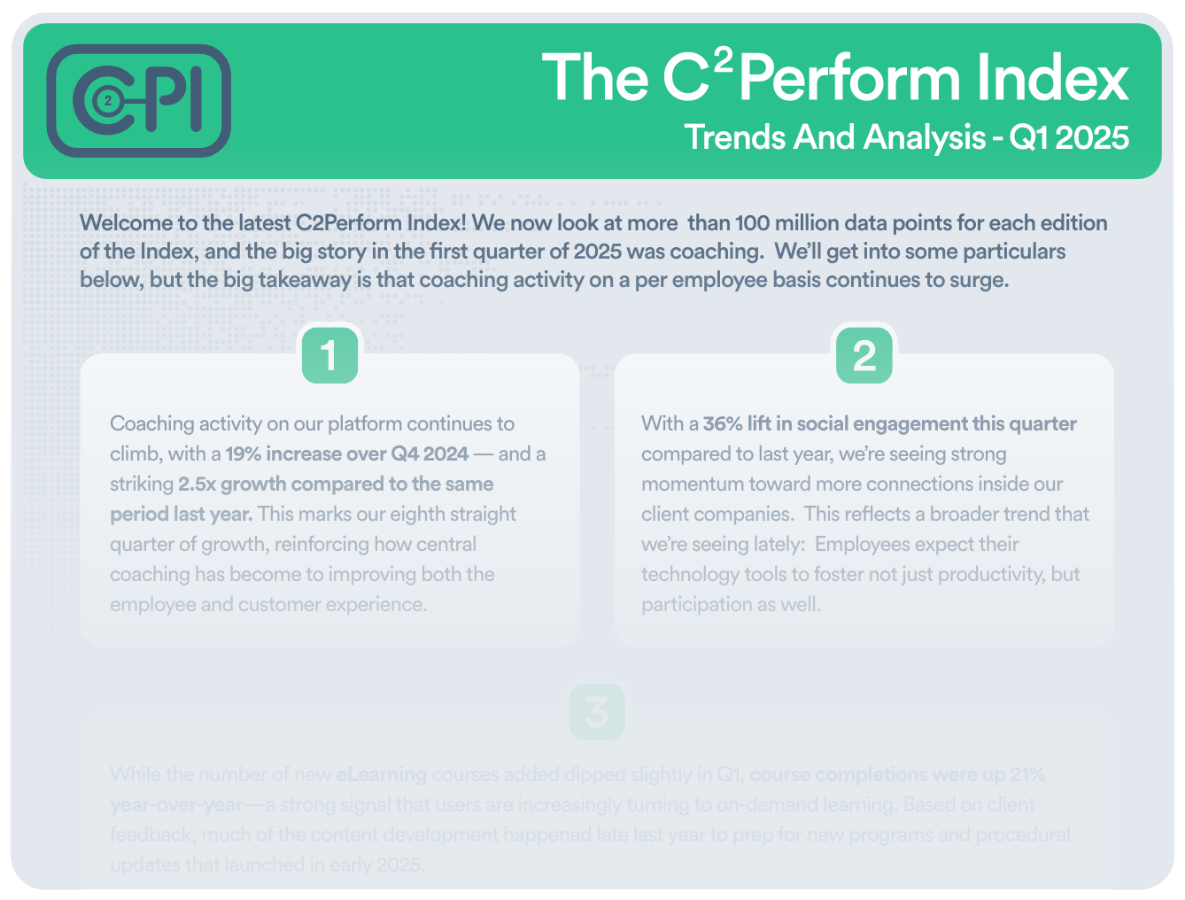Tracking key performance indicators (KPIs) is almost mandatory for any call or contact center operations manager that wants to improve their team’s performance. Tracking the right KPIs can help you identify when your team is doing well and opportunities for improvement.
By leveraging your contact center metrics data, you can pick the best training programs to fit your current needs, encourage the right employees at the right time to maximize motivation, and demonstrate to upper management the ROI for your ongoing employee performance management efforts.
But which metrics are the best ones to track? Moreover, how can you capture data in a timely manner so you can act on it before it’s too late? Let’s talk about how to choose the right call center metrics and how to get the info you need sooner rather than later.
Choosing the Right Call Center Metrics to Track
There are countless potential performance metrics that you could choose to track in your call/contact center—far too many to list and describe them all in a single blog of any reasonable length. Besides, just because you can track a metric doesn’t necessarily mean that you should. There are some KPIs that may not be worth your while to track or may even be actively misleading if you put too much weight on them.
For example, say that you’re managing a contact center specializing in providing tech support. Some metrics, like upsells, may or may not be valid for your operations. While tech support can help recommend better/newer service plans or other paid solutions to clients, the most important metric to track would more likely be the successful call resolution rate or the percentage of calls forwarded to a supervisor.
Why? Because upsell opportunities may not be consistent for all contact center agents—creating skewed results and priorities for the team. Meanwhile, successful call resolutions and calls forwarded to supervisors show how well the employee is handling customer needs without having to transfer the call to others—and every call is an opportunity to work on those metrics.
Of course, if the call/contact center is being tasked with completing more service contract upsells, then that would be the higher-priority KPI to track.
8 Contact Center Performance Indicators to Track
Not all call center performance metrics are specific to one employee. Several good metrics to track are based on individual performance while others are more concerned with the operation's health as a whole in mind. With that being said, some examples of KPIs that you may want to track in your call center include:
1. Time to Answer
How long does it take for a contact center employee to pick up the phone when a call comes in? Does the phone ring for one ring, two rings, or over 30 seconds? Time to answer is a vital KPI for contact centers managing customer support calls because it directly impacts overall customer experience and satisfaction.
2. Call Volume
How many calls does a call/support center agent handle in an hour (or shift, week, etc.), on average? Call volume can be a useful metric for measuring how diligently a contact center agent is applying themselves to their work—though it isn’t everything.
Goals for average call volume can be tricky to set because call length varies so much from one industry or customer need to the next. It can be especially difficult to gauge what an appropriate call volume goal should be for support calls, as different customer issues can require more or less time to resolve—impacting how many calls agents can realistically handle.
For example, if Issue A takes an average of 15 minutes to successfully resolve while Issue B is something that can be fixed in 5 minutes or less, the percentage of Issue A calls vs Issue B calls could create a large change in the call volume agents can handle.
3. Successful Call Resolution Rate/First Call Resolution Rate
How often can a call center agent “successfully” resolve a call with a current customer or prospect? The successful call resolution rate can mean different things to different roles. For sales teams, it means closing a deal or getting an upsell. For customer support, it could mean closing the service ticket by the end of the call.
Knowing what success is for your calls and the percentage of calls that end in it gives you a baseline to improve on. It also helps you identify which employees are excelling at their role and which ones most need help.
4. Transfer Rate
How many calls does an agent in your contact center refer to other departments or to you (or another supervisor)? While transfers are sometimes inevitable, knowing how many calls each employee is transferring to other departments or to supervisors can help you determine:
- If employees are transferring more calls than they need to.
- Whether your automated voice recognition/answering system is routing incoming calls correctly.
- If employees should be given more authority/autonomy/training to resolve specific issues if they’re blocking successful first call resolutions.
Comparing each employee’s average transfer rate against the rest of the department and seeing where those calls were transferred to can be important for improving contact center operations. Additionally, it can help to ask employees why they transferred calls if the reason isn’t apparent from the call data—this can help you identify issues that may be affecting your call resolution rate.
5. Call Center Agent Turnover
How many call center agents are leaving the organization each month, quarter, or year?
While turnover isn’t a valuable metric for assessing individual agent performance, it is a priceless metric for assessing the health of your call center operations. The industry has a notoriously high rate of turnover as a whole—making it difficult to find and keep great agents for long.
Quantifying call center agent turnover can help you get a good idea of how well your company is performing at engaging and motivating employees. If your turnover rate is high, then you know you’ll want to look for ways to reduce that staff churn.
To help you retain future employees, it can help to create an “exit interview” for employees who are leaving. In this interview, you can ask about the reasons for the churn, such as:
- Interpersonal issues with a manager/coworker
- Pay issues
- Job stress
- Found a better opportunity elsewhere
- Family issues/lifestyle change needed
- Medical issues
If the overwhelming majority of your employees who are leaving all cite similar reasons, then you’ll have a better idea of how to reduce voluntary turnover in your call center—and the data to back it up when you pitch your suggestions to others!
6. Peak Hour Traffic
How many incoming/outgoing calls does your team process during “peak” hours? If peak hour traffic exceeds your call center’s capacity to handle it, then your team could end up experiencing excessive stress—contributing to a loss of employee motivation and an increase in turnover.
It can also affect the customer experience. For example, if your call center is short-staffed during peak hours, customers will have to wait longer to clear the wait queue—leading to more dropped calls and increased dissatisfaction with quality of service.
7. Average Call Length
How long does it take for any call to reach resolution on average (either successful or unsuccessful)? The average amount of time each call takes to complete gives you an idea of how many calls each agent should be able to handle per hour or shift, how much labor you need to manage peak hour traffic, and what your staffing needs would be for “off-peak” hours.
This helps you staff your call center more efficiently so you can minimize both agent idle time and stress from overwork.
8. Non-Call Activities/Channel Mix KPIs
Contact centers do more than just answer phones these days. A lot of call centers are also tasked with additional work such as answering online queries from company chatbots and/or voicebots. Tracking the frequency and duration of these non-call activities is important for ensuring that you aren’t overtaxing your call center agents.
For example, say that Bill works in a customer call center for ABC Communications—a cell phone service provider. Recently, his department was tasked with reviewing and answer customer comments on company blogs and answering questions asked of the company’s chatbot that didn’t have an automated answer available.
However, Bill’s employers didn’t adjust his other KPI goals to account for the time he needs to spend on these new activities. So, Bill is now falling behind on his performance goals and management is getting ready to put him on the dreaded performance improvement plan (PIP). Bill, angry that his workload was increased without consideration for his needs, starts rebelling against the company in minor ways—taking more time in between calls than he should, not answering incoming calls right away, and forwarding every call that’s even slightly inconvenient to his manager without checking if he could provide an answer/fix the issue himself.
A few months later, and Bill’s negative attitude has infected the rest of the team—who are all also bitter about the increased workload and lack of consideration. So, productivity goes down, customer complaints go up, and the company starts losing service contracts to a competitor over the lack of support at the support center.
Using a Live Data Dashboard to Track Contact Center Operations
One of the big challenges of tracking call center performance metrics is finding all of the data you want to track and interpreting it. If you’re tracking your data in a variety of different tools, this can mean spending an exorbitant amount of time logging into data tools, assembling reports based on that data, and making collations between relevant data points to draw conclusions.
To streamline this process, it can be incredibly helpful to use a data dashboard tool that you can interface with your data collection tools and display findings in a quick, “mile-high” view where you can see data for multiple calling agents or the team as a whole at a glance.
With data being fed into the dashboard as it’s captured, you can simply log into the dashboard view to take a quick look at your call center metrics. A customizable data dashboard can let you set up quick views to see overall call center health metrics, individual employee performance data, or specific team data as needed. This makes it easy to compare how your team is performing to other teams in the contact center or against the benchmarks you’ve set for each KPI you track.
Some ways that you can use this information include:
- Improving Coaching Sessions. With an “at a glance” view of an employee’s performance data, you can optimize your one-on-one coaching sessions to better address their specific needs. This also helps you save a bit of time on coaching session prep, as all of the most important data you want to track can be displayed on the dashboard.
- Encouraging Competitiveness. What’s better than you being able to see how your call center agents are performing on the dashboard? Turning it into a leaderboard showcasing how each employee is ranking on their goals. This gamification technique encourages competitiveness as agents strive to be the top of the leaderboard for the bragging rights it gives them.
- Simplifying Employee Recognition. Providing simple kudos to your employees can go a long way towards keeping them motivated to do their best. With a data dashboard view, you can see who is performing at their best and crushing their goals—making it easier to pick out the right personnel to congratulate and reward.
- Refining Productivity Goals. Are the goals you’ve set too aggressive or too lenient? If the majority of your employees are struggling to keep up with goals, they may be too hard. On the other hand, if everyone is able to easily meet them, they may be too low to drive results. With a dashboard view of everyone’s performance, you can see if your employees are struggling with or exceeding goals—allowing you to refine them as needed to maximize employee motivation and performance.
- Monitoring Post-Coaching Employee Performance. How well are employees responding to coaching sessions? Are they improving a lot, a little, or not at all? Knowing if employee performance improves after a coaching session can help you determine how effective those sessions are and if you need to revise your coaching strategy.
Start Tracking Your Contact Center Operations in Real Time
Need a reliable dashboard view of your employees’ performance that can update in real time using a variety of data feed integrations from sources such as Microsoft Teams, Oracle, Salesforce, Zendesk, and more?
Schedule a demo of C2Perform now to discover how you can transform the way you manage your contact center operations! With our comprehensive employee performance management platform, you can streamline your performance improvement, employee recognition, and team communication to save time and headaches in your business unit.

 English
English Español
Español










